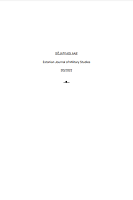CONCEPTS, IDEAS, AND FRAMEWORKS EMERGING FROM OPERATIONAL-TACTICAL WARGAMES
CONCEPTS, IDEAS, AND FRAMEWORKS EMERGING FROM OPERATIONAL-TACTICAL WARGAMES
Author(s): Lauri TeppoSubject(s): Security and defense, Military policy
Published by: Kaitseväe Akadeemia (KVA)
Keywords: wargame; operational factors (time; space; force; and information); key terrain; lines of communication; area of influence; intelligence-fires synergy;
Summary/Abstract: The article describes the operational-tactical phenomena that were observed and analyzed in different wargames. Research was conducted in a qualitative paradigm, using observation as a data collection method and inductive coding as the main data analysis tool. Thereafter, the findings are connected to the existing operational-tactical concepts and, finally, key aspects of wargame design and emerging concepts for warfare are described. The findings are divided into four categories using operational factors as a framework: time, space, force, and information. First, the study provides evidence in category information, i.e., understanding the end-state (victory condition) is vital for success. Second, the research indicates that operational objectives, operational key terrains, and tactical key terrains are interlinked, and their nature and value should be assessed through such connection. In addition, the study emphasizes how the lines of communication and the enemy’s effects on them affect operational reach. The research also revealed the significant effect of the area of influence (AOI) on the enemy’s speed and formation because of the threat generated in the area of influence that is occupied by a friendly force. Findings in the category ‘forces’ highlight the interdependence between joint functions, intelligence and fires, and explain the effects of electronic warfare and cyber-attacks on operational mobility through the disruption of command and control. In the category of ‘time’, the study emphasizes how the relative nature of time (tempo) can affect both sides and how the season can affect the forces. Thereafter, the article continues with a description of important concepts regarding wargame design: first, victory conditions as a combination of operational factors (emphasizing the element of information) and, second, sequencing the game on an operational level by using different combat functions. Finally, there is a description of the validity and utility of a multi-sensor shooter network, highlighting the possibility of employing wargames in training and force development for multinational joint operations in the Baltic States.
Journal: Sõjateadlane
- Issue Year: 2023
- Issue No: 21
- Page Range: 41-63
- Page Count: 23
- Language: English

